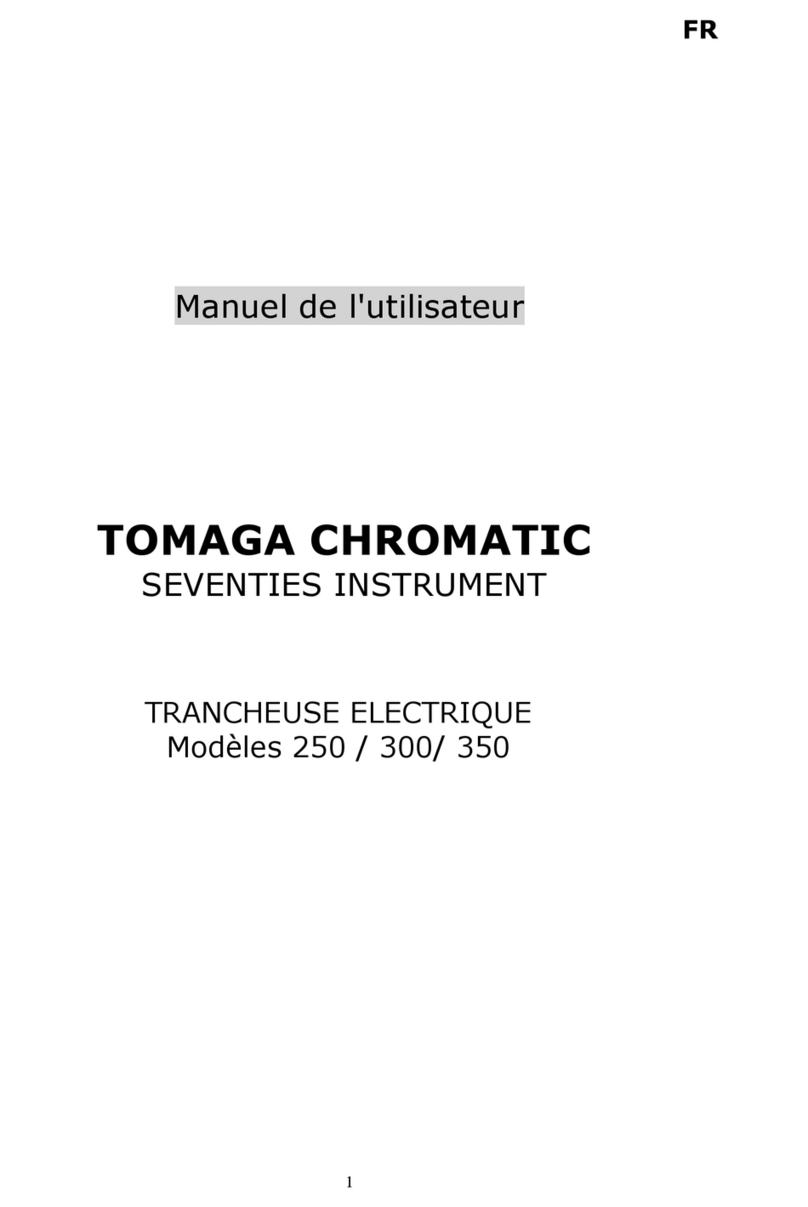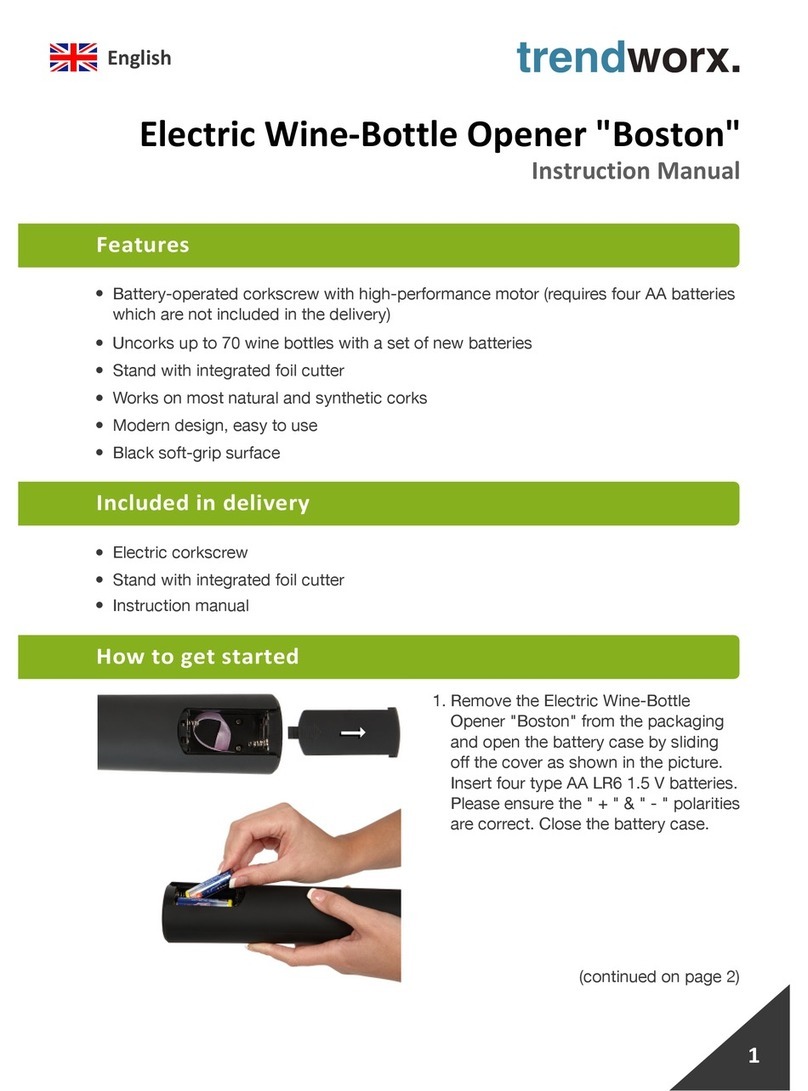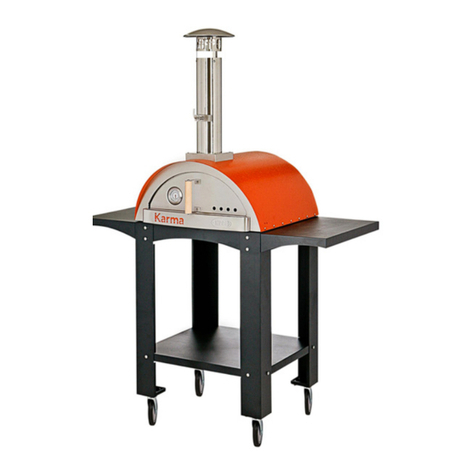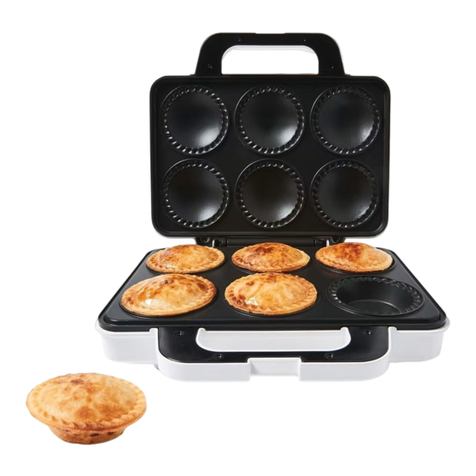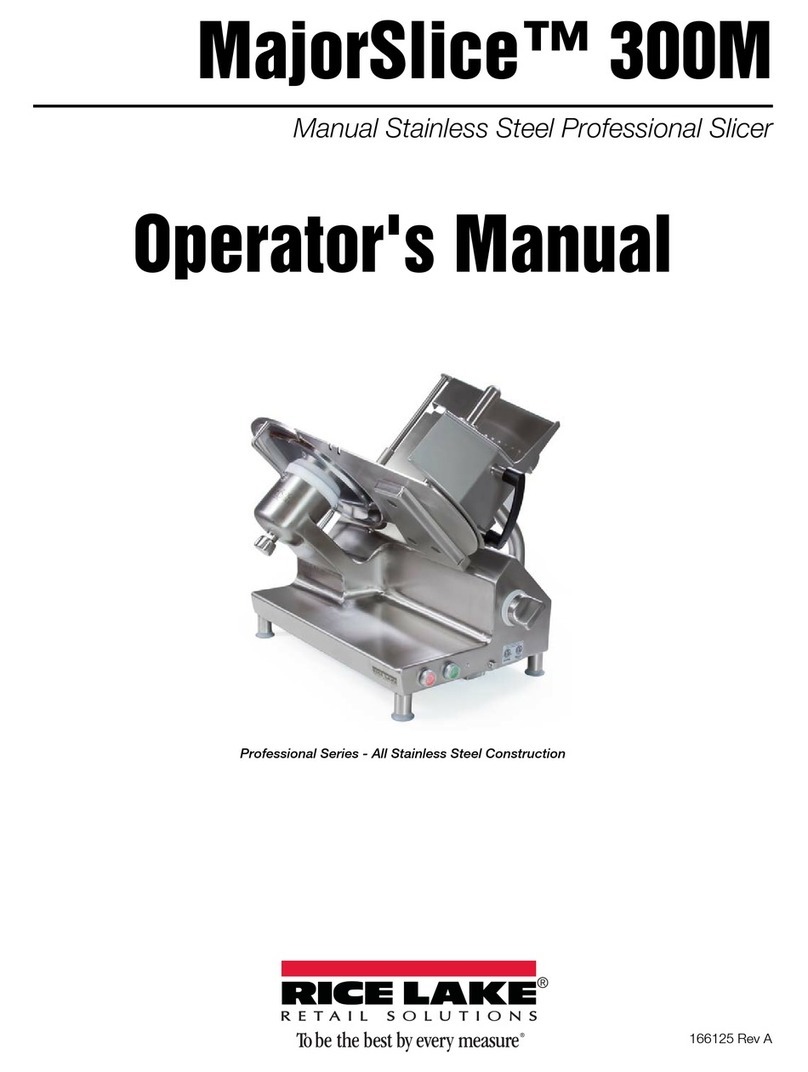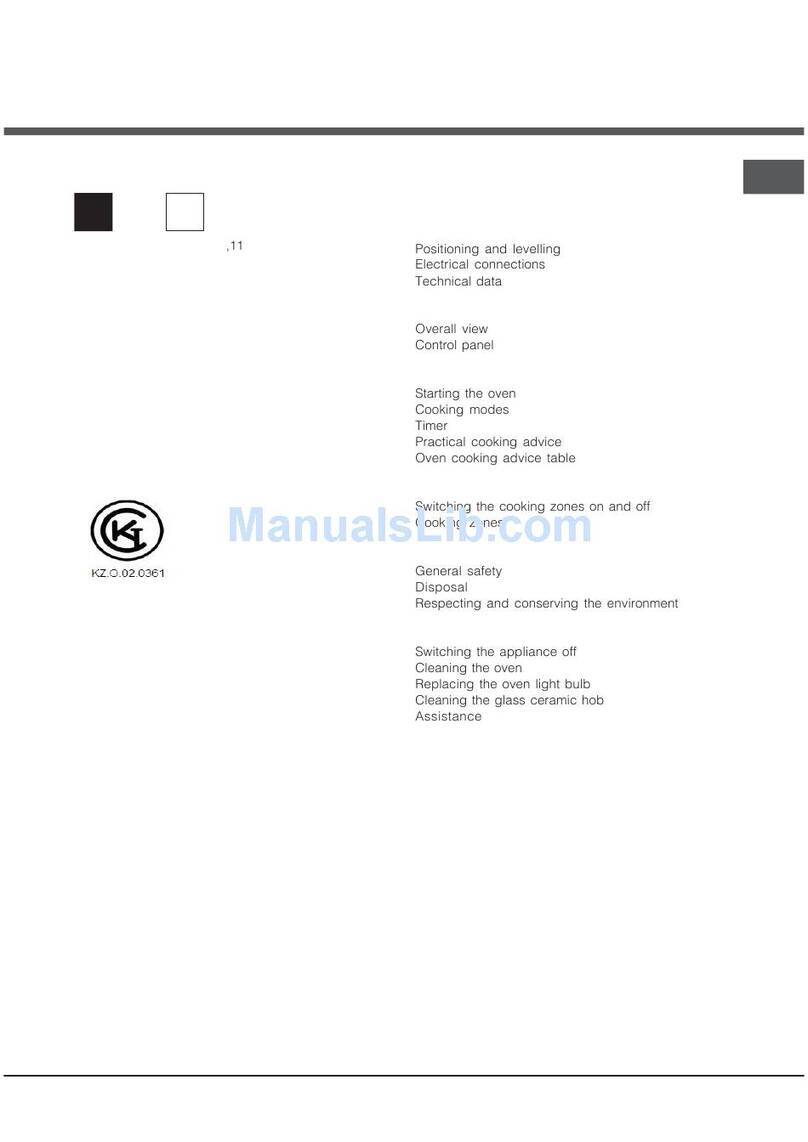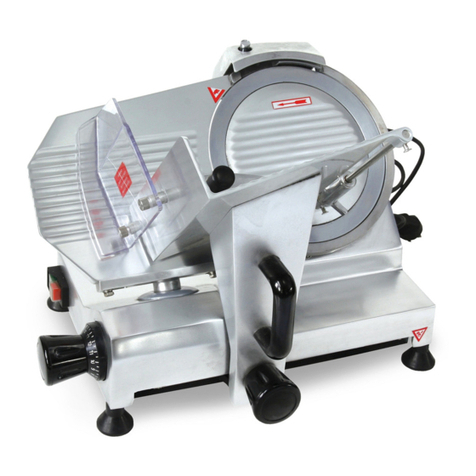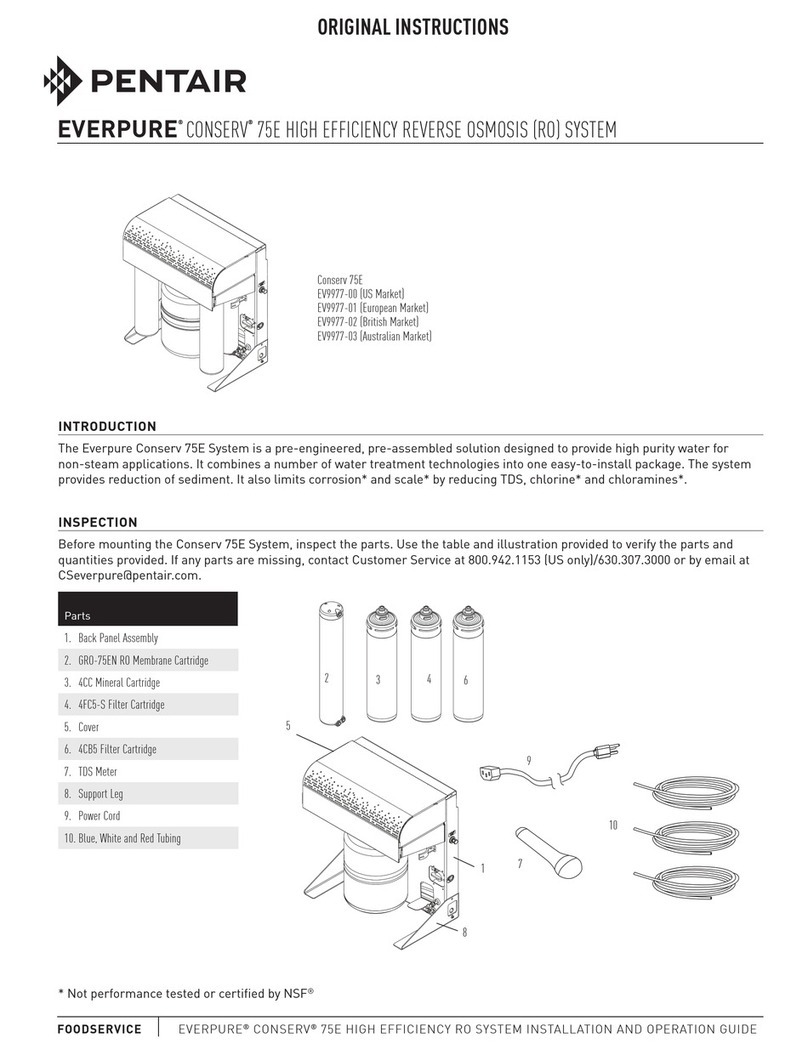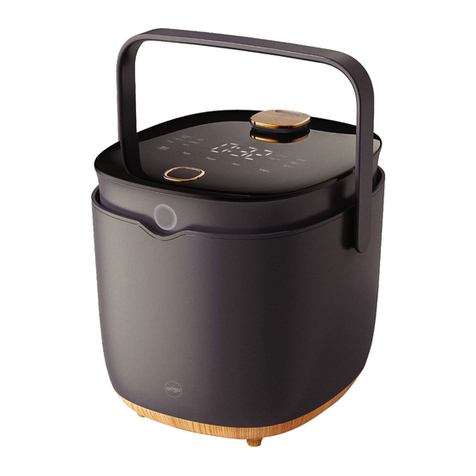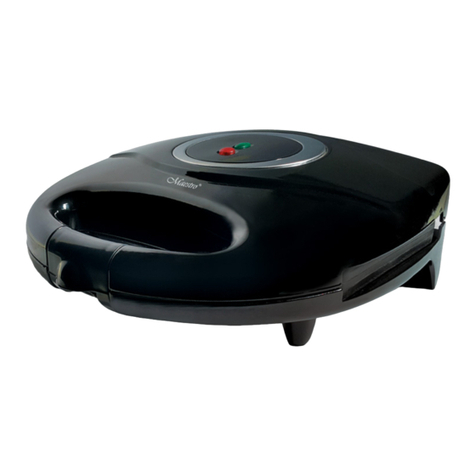tomaga IMPERIAL i33 User manual

superlative instrument
MANUEL DE L’UTILISATEUR • USER GUIDE • MANUALE D’USO • LEHRBUCH DES BENUTZERS

MANUEL DE L’UTILISATEUR
USER GUIDE
MANUALE D’USO
LEHRBUCH DES BENUTZERS
FR
EN
IT
DE
TOMAGA IMPERIAL i33
TRANCHEUSE MÉCANIQUE À VOLANT
TOMAGA INDUSTRIES
3 place Saint-Louis • 78000 Versailles • France
+33(0)1.70.44.19.54 • [email protected]
www.tomaga.fr
IT DICHIARAZIONE DI CONFORMITA’ CE
Il sottoscritto Roberto D’archivio in qualità di legale rappresentante della ditta TOMAGA INDUSTRIES
dichiara che il prodotto sotto indicato è conforme per quanto ad esso applicabile, alle seguenti norme
e direttive CE:
FR DECLARATION DE CONFORMITE CE
Le représentant legal du fabricant, Roberto D’Archivio, declare que le produit susmentionnée est
conforme, quant aux dispositions qui lui sont applicables, aux directives et normatives CE suivantes:
UK DECLARATION OF CONFORMITY CE
The undersigned, legal representative of the manufacturer, Roberto D’Archivio, state that the product
listed above complies with the CE abovementioned directives and regulations:
DE KONFORMITATSERKLARUNG CE
Der unterzeichnende gesetzliche Vertreter der Herstellerrma erklart, dass das oben angegebene
produkt konform mit den oben erwahnten Richtlinien und Normen, soweit auf diese anwendbar ist.
ES DECLARACION DE CONFORMIDAD CE
El representante legal de la empresa costitutiva que suscribe, Roberto D’Archivio, declara que el
producto anteriormente descrito es conforme, en la media aplicable, as las directivas y normativas
arriba mencionadas.
2002/72/EEC • REG.1935/2004/EEC • 2002/95/CE (RoHS) • 2006/42/EEC
EN1974 (per quanto applicabile) • EN ISO 12100-2
N° DE SERIE / N° DI SERIE ANNÉE / ANNO
YEAR / JAHRSERIAL NUMBER / SERIENNUMMER

Page
p. 3
FR
EN
IT
DE
1. AVANT-PROPOS
1.1. OBJECTIF DU MANUEL
Cette publication contient toutes les informations nécessaires pour l’installation, l’emploi et l’entretien
des machines à trancher à volant, manuelles, pour usage alimentaire, avec lame circulaire, Modèle
TOMAGA Imperial i33.
L’objectif de ce manuel est de permettre à l’usager, surtout à l’utilisateur direct, de prendre toutes les
mesures et de prévoir tous les moyens humains et matériels nécessaires pour un emploi sûr et durable
des machines.
1.2. CONSERVATION DU MANUEL
Ce manuel doit être remis à la personne prédisposée à l’emploi et à l’entretien des machines. Il devra
être conservé dans un endroit protégé et sec et il devra toujours être disponible pour consultation. Il est
conseillé d’en garder une copie comme archive.
En cas d’échange d’informations avec le constructeur ou avec le personnel d’assistance autorisé par
celui-ci, indiquer les données fournies sur la plaque et le numéro de série de la machine.
Le manuel doit être conservé pour toute la durée de vie de la machine et en cas de besoin (exemple :
endommagement qui peut en compromettre même partiellement la consultation, etc…), l’usager est
tenu à en acheter une nouvelle copie qu’il demandera exclusivement à TOMAGA Industries. En cas de
cession de la machine, l’usager est invité à signaler au constructeur l’adresse du nouveau propriétaire.
1.3. USAGES AUXQUELS SONT DESTINÉS LES MACHINES
Les usages auxquels sont destinés la machine et les congurations de ces dernières sont les seuls
admis par le constructeur; ne pas tenter d’utiliser la machine en désaccord avec les instructions fournies.
Les machines sont uniquement destinées à la coupe de produits alimentaires de type et dimensions
indiqués dans les paragraphes suivants de ce manuel.
Le constructeur décline toute responsabilité dérivant de l’usage impropre ou de la part de personnel
non qualié; de modications et/ou réparations faites par l’usager ou par du personnel non autorisé;
utilisation de pièces de rechange non originales ou non spéciques pour le modèle de machine.
En cas de doutes sur le contenu du manuel ou pour des éclaircissements contacter
immédiatement le constructeur ou un service d’assistance technique autorisé en citant le
numéro du paragraphe du sujet qui vous intéresse.
2. GÉNÉRALITÉS
2.1. LIMITES D’EMPLOI DE LA MACHINE, NORMES DE SÉCURITÉ
La machine a été conçue et réalisée pour trancher des produits alimentaires, de type et de
dimensions indiqués aux paragraphes 3.2, 3.3 et 3.4.
CONDITIONS ENVIRONNEMENTALES D’EMPLOI DE LA MACHINE
Les conditions de travail prévues doivent respecter les caractéristiques suivantes :
Température : de -5 °C à +40 °C • Humidité max. : 95%
La machine ne peut pas être utilisée à l’extérieur et/ou exposée aux agents atmosphériques et
aux environnements avec vapeurs, fumées ou poussières corrosives et/ou abrasives, avec risque
d’incendie ou d’explosion et où l’on utilise des composants antidéagrants.
1. AVANT-PROPOS
1.1. OBJECTIF DU MANUEL 3
1.2. CONSERVATION DU MANUEL 3
1.3. USAGES AUXQUELS SONT DESTINÉS LES MACHINES 3
2. GÉNÉRALITÉS
2.1. LIMITES D’EMPLOI DE LA MACHINE, NORMES DE SÉCURITÉ 3-4
2.2. GARANTIE ET RESPONSABILITÉ DU CONSTRUCTEUR 5
2.3. OBLIGATIONS DE L’UTILISATEUR 5
2.4. MARQUAGES-PLAQUES 5
3. CARACTÉRISTIQUES TECHNIQUES
3.1. DIMENSIONS D’ENCOMBREMENT 6
3.2. PRINCIPALES DONNÉES TECHNIQUES 6
3.3. PRODUITS POUVANT ÊTRE TRANCHÉS AVEC LA MACHINE 7
3.4. PRODUITS NE POUVANT PAS ÊTRE TRANCHÉS AVEC LA MACHINE 7
4. DESCRIPTION
4.1. OUVERTURE DE L’EMBALLAGE 7
4.2. PRINCIPAUX COMPOSANTS 8-9
4.3. RISQUES LIÉS À L'EMPLOI DE LA MACHINE 9
5. INSTALLATION
5.1. INSTALLATION DE LA MACHINE 10
5.2. DESCRIPTION DES COMMANDES 10
6. EMPLOI DE LA TRANCHEUSE
6.1. CHARGEMENT DES PRODUITS 11
6.2. COUPE DES PRODUITS 11
6.3. NETTOYAGE DE LA TRANCHEUSE 12
7. ENTRETIEN ET RÉPARATION
7.1. GÉNÉRALITÉS 13
7.2. AFFÛTAGE DE LA LAME 13
7.3 LUBRIFICATION 14-15
8. DÉMOLITION DE LA TRANCHEUSE 15
MANUEL DE L’UTILISATEUR
Le manuel est composé de pages numérotées par ordre progressif. Le contenu est subdivisé en
paragraphes également numérotés par odre progressif; en cas de doute ou pour tout éclaircissement,
veuillez contacter le constructeur ou le service d’assistance technique autorisé, en citant le numéro du
paragraphe qui vous intéresse.

p. 5p. 4
FR
EN
IT
DE
POUR UN MEILLEUR EMPLOI DE LA MACHINE, RESPECTER LES CONDITIONS SUIVANTES :
- Installer la machine conformément aux instructions indiquées au paragraphe installation (5);
- Installer la machine dans un endroit hors de la portée de personnel étranger aux opérations
relatives à l’emploi de celle-ci et surtout de mineurs;
- Utiliser la machine avec grande concentration, ne pas se distraire !;
- Ne pas porter de vêtements ottants ou avec des manches ouvertes, utiliser des bonnets de
protection pour contenir les cheveux si nécessaire;
- Ne permettre à personne de s’approcher pendant l’opération de coupe du produit;
- Ne pas enlever, couvrir ou modier les plaques placées sur le corps de la machine et si elles sont
endommagées, les remplacer rapidement;
- Ne pas déplacer les protections et ne pas modier ou ôter les protections mécaniques;
- Ne trancher uniquement que les produits permis, ne faire aucun essai de coupe de produits
interdits;
- Maintenir la zone d’appui du produit tranché, la zone de travail tout autour de la machine et la
surface au sol sur laquelle se trouve l’opérateur toujours propres et sèches;
- Ne pas utiliser la machine comme surface d’appui et n’y poser aucun objet étranger aux
opérations normales de coupe;
- Arrêter immédiatement la machine en cas de défaut, fonctionnement anormal, soupçon de
rupture, mouvements incorrects, bruits insolites, etc…et faire intervenir un service d’assistance
autorisé;
- Utiliser toujours des gants de protection pour les opérations de nettoyage et d’entretien;
- Mettre le produit à trancher sur le plateau coulissant denté et l’enlever seulement lorsque le
plateau est complètement à droite (loin de la lame) et le chariot totalement vers l’opérateur;
- Il n’est pas permis d’employer des accessoires pour la coupe qui ne soient pas fournis par le
constructeur de la machine;
- Pour toute opération d’entretien extraordinaire (remplacement de meule, lame, etc.) s’adresser au
constructeur ou à un personnel qualié et autorisé.
2.3. OBLIGATIONS DE L’UTILISATEUR
Pour pouvoir bénécier de la garantie fournie par le constructeur, l’utilisateur doit respecter
scrupuleusement les prescriptions indiquées dans ce manuel et en particulier :
• Toujours opérer dans les limites d’emploi de la machine;
• Eectuer toujours un entretien constant et soigné;
• Aecter à l’emploi de la machine un personnel ayant des capacités et des aptitudes
adéquates et ayant pris connaissance de ce manuel.
2.4. MARQUAGES-PLAQUES
Celle-ci se trouve sur/sous la base. La plaque est xée à la machine, on y trouve les informations
suivantes :
• plaque d’identication du constructeur,
• n° de série de la machine,
• poids,
• année de construction.
2.2. GARANTIE ET RESPONSABILITÉ DU CONSTRUCTEUR
La garantie de bon fonctionnement et du caractère totalement approprié des machines pour le
service auquel elles sont destinées est liée à la correcte application des instructions contenues
dans ce manuel.
LE CONSTRUCTEUR DÉCLINE TOUTE RESPONSABILITÉ DIRECTE OU INDIRECTE
DÉRIVANT :
• du non respect des instructions contenues dans ce manuel;
• de l’emploi de la machine par du personnel non qualié;
• de l’emploi non conforme aux normes spéciques en vigueur dans le pays d’installation;
• de modications et/ou réparations non autorisées eectuées sur la machine;
• de l’utilisation d’accessoires et de pièces de rechange non originales;
• de faits exceptionnels.
La cession de la machine fait automatiquement déchoir la responsabilité du constructeur si celle-ci
n’est pas accompagnée du manuel correspondant.
Si la machine est cédée à un second utilisateur appartenant à un pays dont la langue serait
diérente, le premier utilisateur est responsable de fournir une copie du manuel suivant traduit
dèlement et correctement dans la langue du pays vers lequel la machine est destinée.
En cas de cession de la machine, le premier utilisateur est tenu de le signaler au constructeur et de
lui envoyer l’adresse du nouvel utilisateur an que celui-ci puisse éventuellement le contacter en
cas d’informations considérées importantes.
NORMES GÉNÉRALES DE SÉCURITÉ
La trancheuse ne doit être utilisée que par du personnel susamment instruit et ayant lu avec
attention le contenu de cette publication.
En qualité d’utilisateur sont admises uniquement des personnes de plus de 18 ans, en parfaites
conditions physiques et psychiques, démontrant de posséder les aptitudes et les capacités
nécessaires (et ayant les connaissances requises) pour l’utilisation et l’entretien de simples
composants mécaniques.

3. CARACTÉRISTIQUES TECHNIQUES
3.1 DIMENSIONS
3.2 PRINCIPALES DONNÉES TECHNIQUES
p. 7p. 6
FR
EN
IT
DE
Dim. en mm
A 808
B 616
C 763
D542
E592
F 75
G451
H341
I 575
Dimensions extérieures
757 x 616 x 592 mm
Dimensions carton
800 L X 640 l X 640 H
Caractéristiques Détails
Capacité (circulaire) 235 mm
Capacité (rectangulaire) 285 x 235h mm
Capacité max. de coupe 0-3 mm
Diamètre Lame 330 mm
Poids 55 kg
3.3. PRODUITS POUVANT ÊTRE TRANCHÉS AVEC LA MACHINE
Les produits que l’on peut trancher sont les suivants:
- Tous tous les types de charcuterie désossée (produits cuits, crus, fumés);
- Viandes sans os (cuites ou crues à une température non inférieure à +3 °C);
3.4. PRODUITS NE POUVANT PAS ÊTRE TRANCHÉS AVEC LA MACHINE
LES PRODUITS QUE L’ON NE PEUT PAS TRANCHER parce qu’ils peuvent causer des
dommages à des biens et des personnes, sont les suivants :
• Produits alimentaires congelés;
• Produits alimentaires surgelés;
• Produits alimentaires avec os (viande et poisson);
• Légumes et fruits en general;
• Tout autre produit qui ne serait pas destiné à l’alimentation.
ATTENTION : NE JAMAIS FAIRE D’ESSAIS DE COUPE SUR DES PRODUITS NON AUTORISÉS
4. DESCRIPTION
4.1. OUVERTURE DE L’EMBALLAGE
Vérier l’intégralité de l’emballage à la livraison; dans le cas contraire, informer immédiatement
l’expéditeur ou l’agent de zone.
Pour ôter la machine de l’emballage, opérer de la façon suivante :
- Avant d’oter l’emballage, rejoindre l’emplacement prévu pour
l’installation
- Couper les sangles autour du carton
- Soulevez le carton par le haut
- Enlever les éléments de protection
AVERTISSEMENT : Les composants de l’emballage sont des
produits assimilables aux déchets solides urbains et peuvent
donc être éliminés sans diculté. On conseille tout de même
d’éliminer séparément les produits (tri sélectif) conformément aux
normes en vigueur pour un recyclage approprié.
ATTENTION : NE PAS JETER LES PRODUITS D’EMBALLAGE DANS L’ENVIRONNEMENT !
FOURNITURE DE LA MACHINE SEULE
- Soulever la machine à deux personnes avec soin, en s’assurant en s’assurant de bonnes prises :
derrière - sous la base devant - par la poigné du volant positionnée obligatoirement en haut, avec le
charriot obligatoirement ramené vers l’avant.
- Positionner la machine sur le plan de travail ou sur son support spécique en vériant la stabilité.
- Vérier que la machine est bien calibrée sur son support et que les pieds n'en dépase pas.
FOURNITURE DE LA MACHINE ET DE SON SUPPORT (OPTION) :
- Soulever la machine à deux personnes avec soin, en s’assurant de bonnes prises.
- Mettre la machine sur son support.
- Vérier que la machine est bien calibrée sur son support et que les pieds n'en dépasent pas.
MATÉRIEL ET ACCESSOIRES FOURNIS AVEC LA
MACHINE
Les documents et accessoires suivants seront fournis
avec la machine :
Manuel d’instructions pour l’emploi et l’entretien.
Accessoires : huile pour le graissage des glissières du
chariot et embout metallique poussoir pour faciliter le
graissage.

4.2. PRINCIPAUX COMPOSANTS
p. 9p. 8
FR
EN
IT
DE
La trancheuse a été conçue et réalisée pour orir un maximum de sécurité pendant l’utilisation,
les opérations de nettoyage et d’entretien; le maximum d’hygiène par l’emploi de matériaux
inoxydables ou en tout cas protégés de façon appropriée contre l’oxydation et une étude soignée
de toutes les parties pouvant entrer en contact avec les aliments à trancher; le maximum de
précision de coupe et de capacité ainsi que solidité et abilité de la structure.
La machine est essentiellement constituée d’une base en fonte vernie lourde et stable, d’une
colonne latérale supportant une lame circulaire, montée en position verticale et d’un chariot
coulissant, parallèlement au l de la lame, qui supporte à son tour un plateau porte-produit.
Le plateau porte-produit denté supporte un bras monté sur deux colonnes verticales qui lui même
est denté et permet de bloquer le produit. Le système de plateau et bras avance automatiquement
vers la lame en fonction de l’épaisseur de coupe sélectionnée.
Le mouvement du chariot et la rotation de la lame sont complètement manuels; en activant le
volant à l’aide de la poignée correspondante, le mécanisme à levier met en mouvement le chariot
et en même temps, avec un renvoi sur chaîne, active la rotation de la lame.
La coupe du produit a lieu durant la course d’aller du chariot, parallèlement à la lame; l’épaisseur
de la tranche est réglable grâce à un dispositif mécanique qui est actionné automatiquement lors
de chaque course de retour du chariot, faisant avancer le plateau supérieur coulissant avec le
produit transversalement par rapport à la lame, d’une valeur réglée auparavant par le biais de la
réglette graduée.
Tous les composants de la machine sont réalisés en fonte, en alliage léger d’aluminium, en
acier inoxydable, conformément aux normes en vigueur relatives à l’hygiène et à la santé sur les
matériaux en contact alimentaire.
La machine est dotée d’un aûteur intégré permettant d’avoir et d’utiliser une lame parfaitement
aiguisée avec un maximum de simplicité d’emploi et de sécurité. Les opérations d’autage sont
indispensables au bon fonctionnement de la machine.
Le plateau porte-produit, l’aûteur, le bac de récupération de déchêts et la protection de la lame
peuvent être démontés pour facilier le nettoyage.
4.3. RISQUES LIÉS À L’EMPLOI DE LA MACHINE
NE PAS utiliser la machine si la personne ne se trouve pas en parfaites conditions physiques et
psychiques, et NE permettre à personne de s’approcher durant l’utilisation de celle-ci; opérer avec
attention durant le chargement et la coupe du produit; NE PAS se distraire !
Couper uniquement les produits autorisés; NE PAS faire d’essais de coupe avec des produits non
autorisés.
ATTENTION : PENDANT LES OPÉRATIONS DE NETTOYAGE, DE GRAISSAGE,
D’AFFÛTAGE DE LA LAME, TOUJOURS UTILISER DES GANTS DE PROTECTION
RÉSISTANTS À LA COUPE ET AUX DÉCHIRURES.
1. Plateau de récupération
2. Protège-tranche
3. Presse-produit
4. Chariot
5. Plateau supérieur denté
6. Poignée de manoeuvre du volant
7. Volant
8. Base
9. Anneau protecteur
10. Poignée pour l’avance de plateau supérieur denté
11. Réglette épaisseur tranche
12. Protection de lame
13. Pied d’appui
14. Lame
15. Aûteur
16. Bac de récupération
13
8
9
16
14
2
3
7
6
10
11
4
12
5
1
15

p. 11p. 10
FR
EN
IT
DE
5. INSTALLATION
5.1. INSTALLATION DE LA MACHINE
Si la machine n’est pas dotée d’une colonne de support (en option) l’installer sur un plan bien mis
à niveau, lisse, sec et capable de supporter le poids de la machine plus le produit à trancher; voir
le paragraphe 3.1.
Vérier qu’il n’y ait pas d’obstacles au mouvement du volant, à la course du chariot et au
chargement du produit à couper sur le plateau.
5.2. DESCRIPTION DES COMMANDES
5.2.1. UTILISATION DU VOLANT
La rotation du volant (1) en sens horaire produit le mouvement du chariot avec le plateau denté
porte-produit et en même temps la rotation de la lame.
5.2.2. RÉGLAGE ÉPAISSEUR TRANCHE
L’épaisseur de la tranche est réglable en positionnant la réglette sur l’échelle graduée (2). Valeurs
de réglage : voir paragraphe 3.2.
5.2.3. PETITE POIGNÉE AVANCE PLATEAU SUPÉRIEUR
La petite manivelle (3) permet de rapprocher rapidement le plateau denté supérieur avec le produit
près de la lame après le chargement de celui-ci ou de l’éloigner en n d’opération de coupe ou lors
de petits déplacements pour réglages.
6. EMPLOI DE LA TRANCHEUSE
6.1. CHARGEMENT DES PRODUITS
• En actionnant le volant (1) mettre le chariot (2) totalement en avant (vers l’opérateur);
• Mettre complètement sur la droite (loin de la lame) le plateau supérieur coulissant (3) en
intervenant sur la petite manivelle (4);
• Faire depasser le produit a trancher d’environ 4 cm du plateau denté vers la lame (5);
• Régler l’épaisseur de tranche désirée en positionnant la réglette (6) sur l’échelle graduée de
0 à 10;
• Approcher (vers la lame) le plateau supérieur avec le produit en intervenant sur la petite
manivelle (4);
6.2. COUPE DES PRODUITS
• Actionner le volant en le faisant tourner exclusivement en sens horaire (ne pas le tourner dans le
sens contraire, la rotation inverse pourrait sérieusement endommager la machine);
• Durant la course en avant du chariot (loin de l’opérateur) le produit entrera en contact avec la
lame et la tranche, guidée par le protège-tranche, il se détachera et tombera sur le plateau de
récupération à gauche. Pour les produits de charcuterie très gras ou très mou, ou bien dans le
cas ou la lame ne serait pas parfaitement autée, il est préférable de prendre et d’accompagner
la tranche car elle pourrait se coller à la lame.
• Durant la course de retour du chariot (vers l’opérateur) le dispositif mécanique qui fait avancer,
en sens transversal le plateau supérieur vers la lame est actionné. L'épaisseur de tranche est
déterminée par la réglette de l'échelle graduée.
34
5
3
1 1
2
6
2

p. 13p. 12
FR
EN
IT
DE
7. ENTRETIEN ET RÉPARATION
7.1. GÉNÉRALITÉS
Aûtage de la lame : périodique; la fréquence et la durée de l’aûtage dépendent évidemment de
l’utilisation de l’appareil (temps de travail et type de produit coupé).
Les opérations d’entretien à coner exclusivement à un personnel autorisé par le constructeur
sont les suivantes :
• Remplacement de la lame.
• Remplacement des meules de l’aûteur.
• Remplacement de la chaîne;
• Réparation des parties formant la structure, réparation et/ou remplacement de com-
posants au-dessous de la base.
7.2. AFFÛTAGE DE LA LAME
Avant l’opération d’autage, il est nécessaire de nettoyer parfaitement la lame pour ne pas salir de
gras les pierres d’autage. Suivre ces instructions en cas de diminution de la capacité de coupe :
ATTENTION : DANGER DE COUPE. UTILISER DES GANTS DE PROTECTION RÉSISTANTS À LA
COUPE ET AUX DÉCHIRURES ET EFFECTUER LES OPÉRATIONS AVEC GRANDE ATTENTION.
• Desserrer le pommeau de blocage de l’aûteur (1).
• Soulever l’aûteur et le tourner de 180° (2).
• Rabaisser avec attention l’aûteur, la lame se centrera automatiquement entre les deux meules.
• Rebloquer le pommeau (3).
• Tourner le volant et au même moment appuyer pendant environ 10-15 secondes sur le bouton
poussoir (4).
• Répéter l’opération si necessaire.
• Interrompre la rotation et contrôler que sur le l de la lame une légère bavure ce soit bien formée.
• Tourner de nouveau le volant et au même moment appuyer pendant environ 5 secondes sur les
deux boutons poussoir (5 et 4).
• Remettre l’aûteur en position d’origine.
• Répéter l’opération de nettoyage de la lame.
REMARQUE : Ne pas trop insister (plus de 2-3 secondes) avec l’opération d’ébavurage an
d’éviter une mauvaise rétorsion du l de la lame.
6.3. NETTOYAGE DE LA TRANCHEUSE
6.3.1. GÉNÉRALITÉS
La machine doit être soigneusement nettoyée après chaque utilisation. Après une période plus ou
moins longue d’inactivité, elle doit être nettoyée aussi avant usage.
Pour ces opérations de nettoyage de lame, particulièrement spéciques et pouvant représenter
de graves risques de coupure, il est indispensable de porter des gants de protection anticoupe.
Il est également préférable de replacer l’anneau de protection de la lame en position fermée (1).
Avec un chion doux humidié et posé sur la lame eectuer un mouvement allant du centre vers
l’extérieur an d’enlever les résidus de graisse et de matière. Répéter cette opération sur les 2
faces de la lame.
ATTENTION : DANGER DE COUPE. UTILISER DES GANTS DE PROTECTION RÉSISTANTS À LA
COUPE ET AUX DÉCHIRURES ET EFFECTUER LES OPÉRATIONS AVEC GRANDE ATTENTION.
- Enlever le bac de récupération produit;
- Desserrer, puis enlever le pommeau (2) et soulever le plateau supérieur coulissant (3) avec le bras
presse-produit correspondant;
Nettoyer toutes les parties démontées, le corps de la machine, etc…, en utilisant uniquement de
l’eau chaud sur un chion doux, un tissu éponge ou éventuellement une brosse en nylon pour
nettoyer les parties du plateau et du presse-produit.
Essuyer à nouveau avec un chion doux.
ATTENTION : NE PAS NETTOYER LA MACHINE AVEC DES JETS D’EAU OU DE VAPEUR
OU D’AUTRES MÉTHODES SIMILAIRES.
1
3
45
2
2
1
3

p. 15p. 14
FR
EN
IT
DE
7.3. LUBRIFICATION. Exemple : Mettre quelques gouttes d’huile dans la
bille entre le volant/corps de la trancheuse (4) et
actionner brièvement le volant.
Pour la lubrication des parties comprenant
une bille métallique, utiliser la pointe
métallique en dotation. Appuyer légèrement
la sphère vers l’intérieur an de créer
l’espace susant pour l’écoulement de
quelques gouttes l’huile.
Tourner le volant pour distribuer l’huile Mettre
quelques gouttes d’huile dans la jointure
de la poignée dentée servant à l’avance
rapide du plateau (1). Tourner le volant pour
distribuer l’huile. Mettre quelques gouttes
d’huile aux points (2), sur la vis apparent
dans la ssure sous le plateau denté.
Cette opération doit être réalisée a plateau
démonté.
Exemple :
Mettre quelques gouttes
d’huile dans la sphère (3).
REMARQUE
UTILISER UNIQUEMENT
DE L’HUILE DE VASELINE,
NE PAS UTILISER
D’HUILES VÉGÉTALES.
8 . DÉMOLITION DE LA TRANCHEUSE
Les machines sont composées de :
• Structure en fonte;
• Pièces en acier inoxydable,
• Pièces en aluminium.
Si le démontage et la démolition sont conés à des tiers, contacter uniquement des entreprises
spécialisées et autorisées pour la récupération et la démolition des tels matériaux.
Si la démolition est eectuée en interne, il est nécessaire de séparer les matériaux suivant leurs
typologies et de contacter par la suite les entreprises autorisées pour leur récupération et leur
démolition. S’en tenir toujours aux normes en vigueur dans le pays où le travail est eectué.
ATTENTION : Dans tous les cas, il est nécessaire de contacter le constructeur ou le personnel
autorisé pour le remplacement de la lame circulaire et pour les opérations successives consistant
à éliminer le l de coupe an que leur démolition ne constitue aucun danger.
ATTENTION : NE JAMAIS ABANDONNER DE FERRAILLE DANS DES ENDROITS OÙ
L’ACCÈS N’EST PAS CONTRÔLÉ OU INTERDIT (BARRIÈRES ET SIGNALÉTIQUE) CAR
CELA REPRÉSENTE DE GRAVES DANGERS POUR LES PERSONNES, EN PARTICULIER
POUR LES MINEURS ET LES ANIMAUX. TOUTES LES RESPONSABILITÉS SONT À
CHARGE DU PROPRIÉTAIRE.
1
3
2
4

Page
p. 17
EN
IT
DE
FR
1. FOREWARD
1.1. PURPOSE OF THE GUIDE
This publication contains all the information required for the installation, use and maintenance
of wheel-operated slicing machines, manual machines, machines intended for food preparation,
those with a circular blade and those of the TOMAGA Imperial i33 model.
This guide seeks to enable users, especially any direct user, to take any steps and implement any
human and material resources required to use the machines in a safe and sustainable manner.
1.2. MAINTAINING THE GUIDE
This guide should be submitted to any persons who are likely to use and maintain the machines. It
must be kept in a protected and dry area and should be available for consultation at any time. You
are advised to keep a copy as part of your records.
In the event of an exchange of information with the manufacturer or the authorised support sta of
the manufacturer, indicate the details provided on the plate and the serial number of the machine.
The guide should be kept for the entire useful life of the machine and, as and when the need
arises, (for instance, if any damage means that it cannot be consulted, even partially, etc.) the
user is required to purchase a new copy which will be requested exclusively from TOMAGA. If the
machine is sold, the user is asked to inform the manufacturer of the address of the new owner.
1.3. INTENDED USE OF THE MACHINES
Only the intended use of the machines and their congurations as established by the manufacturer
will be admitted; do not attempt to use the machine in any way which is not in keeping with the
instructions provided.
The machines are exclusively designed to slice food products of the type and dimensions indicated
in the following paragraphs of this guide.
The manufacturer does not accept any responsibility arising from any improper use by any
unqualied sta; any changes and/or repairs carried out by the user or by any unauthorised
sta; the use of any replacement parts which are dierent from the original or specic ones
recommended for the machine model.
If in doubt about the content of the guide or for any further explanations, please contact the
manufacturer or an authorised help desk immediately, quoting the paragraph number of the
subject you wish to address.
2. GENERAL POINTS
2.1. LIMITATIONS OF USE OF THE MACHINE, SAFETY STANDARDS
The machine has been designed and manufactured to slice food products, of the type and
dimensions indicated in paragraphs 3.2, 3.3 and 3.4.
ENVIRONMENTAL INSTRUCTIONS FOR USE OF THE MACHINE
The established working conditions should respect the following characteristics:
Temperature: from -5 °C to +40 °C • Max. humidity: 95%
The machine may not be used outdoors and/or exposed to atmospheric agents and working
environments with fumes, smoke or corrosive and/or abrasive contaminants, a risk of re or
explosion and in which explosion-proof components are used.
1. FOREWARD
1.1. PURPOSE OF THE GUIDE 17
1.2. MAINTAINING THE GUIDE 17
1.3. INTENDED USE OF THE MACHINES 17
2. GENERAL POINTS
2.1. LIMITATIONS OF USE OF THE MACHINE, SAFETY STANDARDS 17-18
2.2. WARRANTY AND RESPONSIBILITY OF THE MANUFACTURER 19
2.3. OBLIGATIONS OF THE USER 19
2.4. IDENTIFICATION PLATE 19
3. TECHNICAL FEATURES
3.1. OVERALL DIMENSIONS 20
3.2. PRINCIPAL TECHNICAL DATA 20
3.3. PRODUCTS THAT THE MACHINE CAN SLICE 21
3.4. PRODUCTS THAT THE MACHINE CANNOT SLICE 21
4. DESCRIPTION
4.1. OPENING THE PACKAGING 21
4.2. MAIN COMPONENTS 22-23
4.3. RISKS ASSOCIATED WITH THE USE OF THE MACHINE 23
5. INSTALLATION
5.1. INSTALLING THE MACHINE 24
5.2. DESCRIPTION OF ORDERS 24
6. USE OF THE SLICING MACHINE
6.1. LOADING PRODUCTS 25
6.2. SLICING PRODUCTS 25
6.3. CLEANING THE SLICING MACHINE 26
7. MAINTENANCE AND REPAIR
7.1. GENERAL POINTS 27
7.2. SHARPENING THE BLADE 27
7.3. GREASING THE COMPONENTS 28-29
8. DEMOLITION OF THE SLICING MACHINE 29
USER GUIDE
The guide comprises pages numbered consecutively. The content is sub-divided into paragraphs which
are also numbered consecutively; if in doubt or for any explanation, please contact the manufacturer or
the authorised help desk, quoting the paragraph number that you wish to address.

p. 19p. 18
EN
IT
DE
FR
FOR A BETTER USE OF THE MACHINE, PLEASE RESPECT THE FOLLOWING REQUIRE-
MENTS:
- Install the machine in accordance with the instructions indicated in the ‘Installation’ paragraph(5);
- Install the machine in a place which is inaccessible to any sta not involved in operating the
machine and especially any minors;
- Use the machine with great care and attention; do not get distracted!;
- Do not wear any loose clothing or any with bell sleeves; wear protective headgear to keep your
hair tied back if necessary;
- Do not allow anyone to approach the machine during the product slicing operation;
- Do not remove, cover or change the plates located on the body of the machine and if they are
damaged, replace them immediately;
- Do not move the protection and do not modify or remove the mechanical protections;
- Only slice authorised products; never attempt to slice any unauthorised products;
- Make sure that the support area of the sliced product, the work area around the machine and the
surface of the oor on which the operator is working are clean and dry at all times;
- Do not use the machine as a support surface and do not place any item inside which is unrelated
to the normal slicing operations;
- Immediately shut down the machine in the event of a fault, malfunction, suspected breakdown,
irregular movements, strange noises, etc. and arrange for authorised support sta to intervene.
- Always use protective gloves for cleaning and maintenance operations;
- Place the product to be sliced on the sliding tray and remove it only when the tray is completely
on the right hand side (away from the blade) and the carrier is directly facing the operator;
- No accessories may be used for slicing unless they are supplied by the machine manufacturer;
- For an exceptional maintenance operation (replacement of grinding wheel, blade, etc.) contact
the manufacturer or any qualied and authorised sta.
2.3. OBLIGATIONS OF THE USER
To benet from the warranty provided by the manufacturer, the user must strictly comply with the
requirements indicated in this guide and in particular:
• Always operate according to the limitations of use of the machine;
• Always perform constant and careful maintenance operations;
• Allocate sta with the suitable skills and capabilities and who have read this guide to operate
the machine.
2.4. IDENTIFICATION PLATE
This is located on/under the base. The plate is attached to the machine; it contains the following
information:
• manufacturer's identication plate,
• serial no. of the machine,
• technical data,
• weight,
• year of construction.
2.2. WARRANTY AND RESPONSIBILITY OF THE MANUFACTURER
The eective operation warranty and the warranty concerning the perfect suitability of the machines
in terms of the service for which they are intended are connected to the correct application of the
instructions contained in this guide.
THE MANUFACTURER DOES NOT ACCEPT ANY DIRECT OR INDIRECT RESPONSIBILITY
ARISING FROM:
• any failure to comply with the instructions contained in this guide;
• the use of the machine by unqualied sta;
• any use not in keeping with the specic requirements applicable in the country of
installation;
• any unauthorised modications and/or repairs on the machine;
• the use of any accessories and spare parts other than the original ones recommended
for this model;
• any exceptional events.
The sale of the machine automatically excuses the manufacturer from any responsibility if the sale
does not include the relevant guide.
If the machine is sold to a second user belonging to a county where a dierent language is spoken,
the rst user is responsible for providing a copy of the following guide which is faithfully and
correctly translated into the language of the country for which the machine is intended.
If the machine is sold, the rst user is required to notify the manufacturer and to convey the
address of the new user so that the manufacturer can make contact, if necessary, to obtain any
appropriate information.
GENERAL SAFETY STANDARDS
The slicing machine must only be used by properly trained sta who have carefully read the
content of this publication.
Only those who are over the age of 18 and who are in a perfect physical condition and state of
mind and show that they have the necessary skills and capabilities are allowed to operate this
machine (they should also have the knowledge required to use and maintain basic mechanical
components).

3. TECHNICAL FEATURES
3.1 DIMENSIONS
3.2 PRINCIPAL TECHNICAL DATA
p. 21p. 20
EN
IT
DE
FR
Dim. in mm
A 808
B 616
C 763
D542
E592
F 75
G451
H341
I 575
Outer dimensions
757 x 616 x 592 mm
Box dimensions
800 L X 640 W X 640 H
Characteristics Details
Capacity (circular) 235 mm
Capacity (rectangular) 285 x 235h mm
Max. slicing capacity 0-3 mm
Blade diameter 330 mm
Weight 55 kg
3.3. PRODUCTS THAT THE MACHINE CAN SLICE
The following products can be sliced:
- Any kind of meat product (cooked, raw, smoked products);
- Boneless meats (cooked or raw at a temperature not below +3 °C);
3.4. PRODUCTS THAT THE MACHINE CANNOT SLICE
The following products may not be sliced because they can cause damage to property and/or
people:
• Frozen food products;
• Quick-frozen food products;
• Food products with bones (meat and sh);
• Fruits and vegetables in general;
• Any other product which is not intended for food preparation.
N.B.: NEVER CARRY OUT ANY SLICING TESTS ON UNAUTHORISED PRODUCTS
4. DESCRIPTION
4.1. OPENING THE PACKAGING
Check all packaging upon delivery; if any packaging is missing,
immediately inform the shipper or the area ocial.
To remove the machine from the packaging, follow the procedure
below:
- Before removing the packaging, go to the place where the
machine is set to be installed
- Cut the straps around the cardboard.
- Open the box from the top
- Remove any protective materials
N.B.: As they can be treated as solid urban waste, it is easy to
dispose of the packaging materials. You are however advised to
dispose of the products separately (selective sorting) according to
applicable standards for appropriate recycling.
N.B: DO NOT DISPOSE OF THE PACKAGING PRODUCTS INTO THE ENVIRONMENT!
MACHINE SUPPLIED BY ITSELF
- Two people should carefully lift the machine, making sure they have a tight grip.
Behind - in front of the base - by the handle of the steering wheel positioned necessarily top, with
the mandatory carriage brought forward .
- Place the machine on the work surface or on its particular base while checking that it is stable.
- Check that the machine is correctly balanced on its base and that the stand is steady.
MACHINE SUPPLIED ALONG WITH ITS BASE (OPTIONAL):
- Two people should carefully lift the machine, making sure they have a tight grip.
- Place the machine on its base.
- Check that the machine is correctly balanced on its base and that the stand is steady.
MATERIAL AND ACCESSORIES SUPPLIED WITH
THE MACHINE
The following documents and accessories will be
supplied with the machine:
Instruction guide for use and maintenance.
Accessories: oil for greasing of carrier guides and
metal cap to facilitate greasing.

4.2. MAIN COMPONENTS
p. 23p. 22
EN
IT
DE
FR
The slicing machine has been designed and produced to guarantee maximum safety during use,
cleaning and maintenance; optimum health and safety standards are guaranteed by the use of
stainless steel materials or, at any rate, materials which are suitably protected against oxidisation
and by a careful study of all parts which may come into contact with any food products to be
sliced; optimum slicing precision and capacity are provided as well as the solidity and reliability of
the structure.
The machine essentially consists of a heavy and stable varnished cast iron base, a lateral column
to support a circular blade, placed vertically and a sliding carrier which lies parallel to the tip of the
blade and which in turn supports a product-carrying tray.
The jagged product-carrying tray supports an arm mounted on two vertical columns which is also
jagged and means that the product can be jammed in. The tray and arm system automatically
moves towards the blade according to the selected slicing thickness.
The movement of the carrier and the rotation of the blade are completely manual; by activating the
wheel using the relevant handle, the lever mechanism activates the carrier and, at the same time,
with a chain pulley, activates the blade rotation.
The product is sliced as the carrier moves forwards parallel to the blade; the thickness of the slice
is adjustable by a mechanical device which is activated automatically when the carrier is brought
back, as it moves the upper sliding tray with the product in a crosswise direction towards the
blade, with a previously adjusted value by means of the graduated ruler.
All the components of the machine are made out of cast iron, a light aluminium alloy, stainless
steel, in accordance with applicable standards relating to health and safety on materials coming
into contact with food.
The machine is equipped with an integrated sharpener which means that a perfectly sharpened
blade can be achieved which provides maximum ease of use and safety. The sharpening
operations are essential for the machine to operate in an eective way.
The product-carrying tray, the sharpener, the waste recovery container and the blade protection
can be dismantled to facilitate cleaning.
4.3. RISKS ASSOCIATED WITH THE USE OF THE MACHINE
The machine SHOULD NOT BE used by any person who is not in a perfect physical condition and
state of mind; DO NOT allow any person to approach when the machine is in use; operate with care
whenever the product is being loaded or sliced; DO NOT get distracted!
Only slice authorised products: DO NOT perform slicing tests on any unauthorised products.
N.B: DURING CLEANING, GREASING AND BLADE SHARPENING OPERATIONS,
ALWAYS USE PROTECTIVE CUT AND TEAR RESISTANT GLOVES.
1. Recovery tray
2. Slice protection
3. Product press
4. Carrier
5. Upper sliding tray
6. Wheel-activated handle
7. Wheel
8. Base
9. Protective ring
10. Handle for activating the upper tray
11. Slice thickness ruler
12. Blade protection
13. Support stand
14. Blade
15. Sharpener
16. Recovery container
8
9
16
14
2
3
7
4
1
15
13
6
10
11
12
5

p. 25p. 24
EN
IT
DE
FR
5. INSTALLATION
5.1. INSTALLING THE MACHINE
If the machine is not equipped with a support column (optional), install it on a at, soft and dry
surface which is able to support the weight of the machine plus the product to be sliced; see
paragraph 3.1.
Check that there are no obstacles in the way when the wheel is activated, when the carrier is
moving and when the product to be sliced is loaded on the tray.
5.2. DESCRIPTION OF ORDERS
5.2.1. USE OF THE WHEEL
The wheel (1) rotated clockwise moves the carrier with the jagged product-carrying tray and also
rotates the blade at the same time.
5.2.2. SLICE THICKNESS ADJUSTMENT
The slice thickness is adjustable by placing the ruler on the graduated scale (2). Adjustment values:
see paragraph 3.2.
5.2.3. SMALL HANDLE TO MOVE THE UPPER TRAY FORWARD
The small handle (3) enables the jagged upper tray with the product to advance quickly towards
the blade after the product has been loaded or to move away at the end of the slicing operation or
during small movements for the purpose of adjustment.
6. USE OF THE SLICING MACHINE
6.1. LOADING PRODUCTS
• When activating the wheel (1), bring the carrier (2) completely forward (towards the operator);
• Place the upper sliding tray on the right (away from the blade) by activating the small handle
(4);
• Place the product to be sliced on the upper tray and jam it in using the product press (5) by
also adjusting the height;
• Adjust to the desired slice thickness by placing the ruler (6) on the graduated scale from 0
to 10;
• Bring the upper tray with the product (towards the blade) by activating the small handle (4);
6.2. SLICING PRODUCTS
• Activate the wheel turning clockwise exclusively (do not turn it anti-clockwise, as inverse
rotation could seriously damage the machine);
• When the carrier moves forwards (away from the operator), the product will come into contact
with the blade and the slice, guided by the slice protection, and will become detached and
fall into the recovery tray on the left. With respect to very fatty or very soft meat products, or
even if the blade is not completely sharpened, it is preferable to take and support the slice
as it may stick to the blade.
• When the carrier moves backwards (towards the operator), the mechanical device which
advances the upper plate in a crosswise direction towards the blade is activated. The slice
thickness is established by the ruler of the graduated scale.
34
5
3
1 1
2
6
2

p. 27p. 26
EN
IT
DE
FR
7. MAINTENANCE AND REPAIR
7.1. GENERAL POINTS
Sharpening the blade: regular; the frequency and duration of the sharpening obviously depend on
the use of the device (working time and type of product being sliced).
Maintenance operations to be exclusively assigned to authorised sta by the manufacturer are
as follows:
• Replacing the blade.
• Replacing the grinding wheel of the sharpener.
• Replacing the chain;
• Repair of parts by which the structure is concerned, repair and/or replacement of
components above the base.
7.2. SHARPENING THE BLADE
Before the sharpening operation, it is necessary to thoroughly clean the blade so as not to taint the
grinding stones with grease. Follow these instructions if the slicing capacity falls:
N.B: SLICING RISKS. USE CUT AND TEAR RESISTANT PROTECTIVE GLOVES AND PERFORM
THE OPERATIONS WITH GREAT CARE.
• Loosen the sharpening blocking knob (1).
• Lift the sharpener and turn it 180° (2).
• Carefully lower the sharpener, the bade will automatically lodge between the two grinding
wheels.
• Tighten the knob (3).
• Turn the wheel and at the same time press on the button (4) for about 10-15 seconds.
• Interrupt the rotation and monitor whether a slight rough edge is eectively formed on the
blade tip.
• Turn back the wheel and at the same time press for about 5 seconds on two push buttons (5 and 4).
• Return the sharpener to its original position.
• Repeat the blade cleaning operation.
NOTE: Do not press excessively (more than 2-3 seconds) during deburring so that the blade
tip is not adversely aected.
6.3. CLEANING THE SLICING MACHINE
6.3.1. GENERAL POINTS
The machine should be carefully cleaned after each use. After a relatively long period of inactivity,
it should be cleaned before each use too.
For these blade cleaning operations, which are particularly specic and which may result in serious
slicing risks, it is essential to wear cut resistant gloves. It is also preferable to replace the protective
blade ring in a closed position (1).
With a soft damp cloth placed on the blade, rub from in to out to remove any residue of grease and
matter. Repeat this operation on both sides of the blade.
N.B: SLICING RISKS. USE CUT AND TEAR RESISTANT PROTECTIVE GLOVES AND PERFORM
THE OPERATIONS WITH GREAT CARE.
- Remove the product recovery container;
- Loosen and then remove the knob (2) and lift the upper sliding plate (3) with the corresponding
product press arm;
Clean all dismantled parts, the body of the machine etc. using only warm water and a soft cloth, a
spongy fabric or even a nylon brush to clean the parts of the tray and the product press.
Wipe all parts again with a soft cloth.
N.B: DO NOT CLEAN THE MACHINE WITH A WATER PUMP OR STEAM
OR OTHER SIMILAR METHODS.
1
3
45
2
2
1
3

p. 29p. 28
EN
IT
DE
FR
7.3. GREASING Exemple : Put a few drops of oil in the joints
of the wheel/body of the slicing machine (4) and
briey activate the wheel.
To lubricate the indicated parts which
include a metal ball, use the metal tip
provided. Softly push the sphere inside to
create enough space for the oil to ow.
Turn the steering wheel to distribute the oil.
Set few drops of oil in the join of the ring
handle for advance Quick tray (1). Turn the
steering wheel to distribute the oil. Put a
few drops in points oil (2), on the apparent
screw in the crack under the toothed plate
. This operation must be carried out tray
has dismounted.
Put a few drops of oil in the
sphere (3).
NOTE
ONLY USE VASELINE OIL,
DO NOT USE VEGETABLE OIL.
8 . DEMOLITION OF THE SLICING MACHINE
The machines consist of:
• Structure made from cast iron and an aluminium alloy;
• Stainless steel parts.
If the dismantling and demolition operations are assigned to third parties only contact specialised
companies who are authorised to recover and destroy these materials.
If the demolition is performed internally, it is necessary to separate the materials in keeping with
their typologies and subsequently contact any companies authorised to recover and destroy
them. Always respect the regulations applicable in the country where the work is being carried
out.
N.B: At any rate, it is necessary to contact the manufacturer or the authorised sta to replace the
circular blade and for any successive operations which consist of removing the slicing tip so that
they can be destroyed in complete safety.
N.B: NEVER LEAVE ANY SCRAP IRON IN PLACES WHERE ACCESS IS NOT
MONITORED OR IS FORBIDDEN (BARRIERS AND SIGNAGE) AS IT REPRESENTS A
SERIOUS DANGER FOR PEOPLE, ESPECIALLY FOR MINORS AND ANIMALS. THE
OWNER ACCEPTS FULL RESPONSIBILITY.
1
3
4
2

Pagine
p. 31
FR
EN
IT
DE
1. PREMESSA
1.1. SCOPO DEL MANUALE
Questa pubblicazione contiene tutte le informazioni necessarie per l’installazione. l’uso e la manutenzione
delle macchine aettatrici a volano manuali, per uso alimentare, con lama circolare, Mod. TOMAGA
IMPERIAL i33.
Scopo del presente manuale è quello di consentire all’utente, soprattutto al diretto utilizzatore, di
prendere ogni provvedimento e predisporre tutti i mezzi umani e materiali necessari, per un uso sicuro
e duraturo delle macchine.
1.2. CONSERVAZIONE DEL MANUALE
Questo manuale deve essere consegnato alla persona preposta all’uso e alla manutenzione delle
macchine, che provvederà alla sua conservazione in luogo protetto ed asciutto, sempre disponibile per
la consultazione. Si consiglia di tenere un’eventuale copia in archivio.
In caso di scambio di informazioni con il costruttore o con personale di assistenza da questi autorizzato,
fare riferimento ai dati di targa ed al numero di matricola della macchina.
Il manuale deve essere conservato per tutta la vita della macchina ed in caso di necessità (esempio:
danneggiamento che ne comprometta anche parzialmente la consultazione, ecc.) l’utente è tenuto
all’acquisizione di una nuova copia da richiedere esclusivamente a Tomaga Industries. In caso di
cessione della macchina l’utente è invitato a segnalare al costruttore l’indirizzo del nuovo proprietario.
1.3. DESTINAZIONE D’USO DELLE MACCHINE
La destinazione d’uso e le congurazioni previste della macchina sono le uniche ammesse dal
costruttore; non tentare di utilizzare le macchine in disaccordo con le istruzioni fornite.
Le macchine sono destinate solo al taglio di prodotti alimentari del tipo e nei limiti dimensionali indicati
nei paragra seguenti.
Il costruttore declina ogni responsabilità derivante da: Uso improprio o da parte di personale che non
abbia letto e compreso a fondo il contenuto del presente manuale; Modiche e/o riparazioni eettuate
in proprio; Utilizzo di parti di ricambio non originali o non specici per il modello di macchina. In
caso di dubbi sul contenuto del manuale o per chiarimenti contattare immediatamente il
costruttore o un servizio di assistenza tecnica autorizzato citando il numero del paragrafo
dell’argomento che vi interessa.
2. GENERALITA’
2.1. LIMITI D’IMPIEGO DELLA MACCHINA, NORME DI SICUREZZA
La macchina è stata progettata e realizzata per aettare prodotti alimentari del tipo e nei limiti
dimensionali come indicato ai paragra 3.2, 3.3 e 3.4.
CONDIZIONI AMBIENTALI D’IMPIEGO DELLA MACCHINA
L’ambiente operativo previsto deve avere le seguenti caratteristiche:
Temperatura : da -5 °C a +40 °C • Umidità relativa max. : 95%
La macchina non può essere impiegata in luoghi aperti e/o esposta agli agenti atmosferici e in
ambienti con vapori, fumi o polveri corrosivi e/o abrasivi, con rischio di incendio o esplosione e
comunque dove sia prescritto l’impiego di componenti antideagranti
1. PREMESSA
1.1. SCOPO DEL MANUALE 31
1.2. CONSERVAZIONE DEL MANUALE 31
1.3. DESTINAZIONE D’USO DELLE MACCHINE 31
2. GENERALITA’
2.1. LIMITI D’IMPIEGO DELLA MACCHINA, NORME DI SICUREZZA 31-32
2.2. GARANZIA E RESPONSABILITÀ DEL COSTRUTTORE 33
2.3. OBBLIGHI DELL’UTILIZZATORE 33
2.4. TARGHE 33
3. CARATTERISTICHE TECNICHE
3.1. DIMENSIONI D’INGOMBRO 34
3.2. DATI TECNICI PRINCIPALI 34
3.3. PRODOTTI CHE SI POSSONO AFFETTARE 35
3.4. PRODOTTI CHE NON SI POSSONO AFFETTARE 35
4. DESCRIZIONE
4.1. APERTURA DELL’IMBALLO 35
4.2. COMPONENTI PRINCIPALI 36-37
4.3. RISCHI LEGATI ALL’USO DELLA MACCHINA 37
5. INSTALLAZIONE
5.1. INSTALLAZIONE DELLA MACCHINA 38
5.2. DESCRIZIONE DEI COMANDI 38
6. USO DELL’AFFETTATRICE
6.1. CARICAMENTO MERCE 39
6.2. TAGLIO MERCE 39
6.3. PULIZIE DEL AFFETTATRICE 40
7. MANUTENZIONE E RIPARAZIONE
7.1. GENERALITÀ 41
7.2. AFFILATURA DELLA LAMA 41
7.3. LUBRIFICAZIONE 42-43
8. DEMOLIZIONE DELL’AFFETTATRICE 43
MANUALE D’USO ITALIANO
La presente pubblicazione è costituita da pagine numerate progressivamente.
Il contenuto è suddiviso in paragra anch’essi numerati progressivamente; in caso di dubbi e per ogni
chiarimento contattare il costruttore o il servizio di assistenza autorizzato citando il numero del paragrafo
dell’argomento che vi interessa.

p. 33p. 32
FR
EN
IT
DE
PER UN USO SICURO RISPETTARE LE SEGUENTI INDICAZIONI :
- Installare la macchina in conformità alle istruzioni riportate al paragrafo (5) ‘installazione’;
- Installare la macchina in luogo al di fuori dalla portata di personale estraneo alle operazioni
relative all’impiego della stessa e soprattutto di minori;
- Utilizzare la macchina con grande concentrazione, non distrarsi!;
- Non indossare indumenti svolazzanti o con maniche aperte, utilizzare opportuno copricapo per
contenere i capelli, se necessario;
- Non permettere ad alcuno di avvicinarsi durante l’operazione di taglio del prodotto;
- Non rimuovere, coprire o modicare le targhette collocate sul corpo macchina e, in caso di
danneggiamento delle stesse, sostituirle prontamente;
- Non rimuovere le protezioni e non modicare o escludere le protezioni meccaniche;
- Aettare unicamente i prodotti di tipo consentito, non tentare alcuna prova di taglio con prodotti di
tipo proibito;
- Mantenere la zona di appoggio del prodotto aettato, la zona tutt’intorno alla macchina ed il piano
pavimento operatore sempre puliti ed asciutti;
- Non utilizzare la macchina come supercie di appoggio e non appoggiarvi alcun oggetto estraneo alle
normali operazioni di taglio;
- Arrestare immediatamente la macchina e richiedere l’intervento di personale di assistenza autorizzato
in caso di funzionamento anomalo, sospetto di rotture, movimenti non corretti, rumori insoliti, ecc.;
- Utilizzare sempre guanti del tipo resistente al taglio ed alla lacerazione per le operazioni di pulizia e
di manutenzione;
- il carico e lo scarico del prodotto da aettare sul piatto dentato va eettuato unicamente col piatto
dentato stesso tutto a destra (lontano dalla lama)
- Non è ammesso l’uso di accessori per il taglio che non siano stati forniti dal costruttore della macchina;
- Per ogni intervento di manutenzione straordinaria (sostituzione smerigli di alatura , lama, ecc.)
rivolgersi al costruttore o a personale di assistenza autorizzato
2.3. OBBLIGHI DELL’UTILIZZATORE
L’utilizzatore per potere usufruire della garanzia del costruttore deve osservare scrupolosamente le
prescrizioni riportate nel presente manuale e in particolare:
• Operare sempre nei limiti di impiego della macchina;
• Eettuare sempre una costante e diligente manutenzione;
• Adibire all’uso della macchina personale di capacità ed attitudine adeguate, opportunamente
istruito anche con la lettura del presente manuale.
2.4. TARGHE
Sulla base della macchina è posta una targhetta con i dati tecnici seguenti :
• Identicazione del costruttore,
• Numero di serie,
• Anno di costruzione,
• Peso.
2.2. GARANZIA E RESPONSABILITA’ DEL COSTRUTTORE
la garanzia di buon funzionamento e di piena rispondenza delle macchine al servizio cui sono
destinate è legata alla corretta applicazione delle istruzioni contenute in questo manuale.
IL COSTRUTTORE DECLINA OGNI RESPONSABILITÀ DIRETTA ED INDIRETTA DERIVANTE DA :
• Inosservanza delle istruzioni contenute nel manuale;
• Uso da parte di personale che non abbia letto e compreso a fondo il contenuto del
presente manuale;
• Uso non conforme a speciche normative vigenti nel luogo di installazione;
• Modiche e/o riparazioni eettuate sulla macchina e non autorizzate;
• Utilizzo di accessori non forniti dal costruttore e di parti di ricambio non originali;
• Eventi eccezionali.
La cessione della macchina fa automaticamente decadere la responsabilità del costruttore se non
è accompagnata dal relativo manuale.
Qualora la macchina venisse ceduta ad un secondo utilizzatore di un paese con altra lingua della
comunità, sarà responsabilità dell’utilizzatore primario fornire una copia del presente manuale
tradotta fedelmente e correttamente nella lingua del paese in cui la macchina si troverà ad operare.
In caso di cessione della macchina inoltre l’utilizzatore primario è invitato a segnalare al costruttore
l’indirizzo del nuovo utilizzatore anché sia possibile raggiungerlo con eventuali comunicazioni
ritenute indispensabili.
NORME GENERALI DI SICUREZZA
L’aettatrice deve essere utilizzata solo da personale che abbia attentamente letto quanto
contenuto in questa pubblicazione.
In qualità di operatore sono ammesse unicamente persone di età superiore ai 18 anni, in perfette
condizioni psicosiche, di provata attitudine e capacità (con cognizioni necessarie per il normale
utilizzo e manutenzione di semplici componenti meccanici).

3. CARATTERISTICHE TECNICHE
3.1 DIMENSIONI
3.2 PRINCIPALI DATI TECNICI
p. 35p. 34
FR
EN
IT
DE
Dim. in mm
A 808
B 616
C 763
D542
E592
F 75
G451
H341
I 575
Dimensioni esterne
757 x 616 x 592 mm
Dimensioni del cartone
800 L X 640 l X 640 H
Caratteristiche Dettagli
Capacità (circolare) 235 mm
Capacità (rettangolare) 285 x 235h mm
Capacità mass. di taglio 0-3 mm
Diametro Lama 330 mm
Peso 55 kg
3.3. PRODOTTI CHE SI POSSONO AFFETTARE
I prodotti che si possono aettare sono i seguenti:
- Tutti i tipi di salumi (cotti, crudi, aumicati), purché disossati
- Carni disossate (cotte o crude ad una temperatura non inferiore ai +3 °C);
3.4. PRODOTTI CHE NON SI POSSONO AFFETTARE
I PRODOTTI CHE NON SI POSSONO AFFETTARE perché possono provocare seri danni a cose
e a persone sono i seguenti:
• Prodotti alimentari congelati;
• Prodotti alimentari surgelati;
• Prodotti alimentari con osso (carne e pesce);
• Frutta e verdure in genere;
• Ogni altro prodotto del tipo aettabile ma non destinato all’uso alimentare
ATTENZIONE: IN NESSUN CASO TENTARE PROVE DI TAGLIO CON PRODOTTI DEL TIPO PROIBITO.
4. DESCRIZIONE
4.1. APERTURA DELL’IMBALLO
Vericare che alla consegna l’imballo sia integro; in caso contrario informare immediatamente lo
spedizioniere o l’agente di zona.
Per togliere la macchina dall’imballo operare come segue:
- Prima di togliere l’imballo si consiglia di raggiungere la zona
prevista per l’installazione tagliare le fasce di ssaggio tra il cartone
e la pedana.
- slare il cartone dal basso verso l’alto ed eliminare i materiali di
protezione della macchina
AVVERTENZA: I componenti l’imballo, (cartone, distanziali, ecc.)
sono prodotti assimilabili ai riuti solidi urbani quindi possono
essere smaltiti senza alcuna dicoltà. Si consiglia comunque
di smaltire separatamente i prodotti (raccolta dierenziata) in
conformità alle normative vigenti per un adeguato riciclaggio.
ATTENZIONE: NON DISPERDERE I PRODOTTI DELL’IMBALLO NELL’AMBIENTE!
FORNITURA DELLA SOLA MACCHINA
- Raggiungere il luogo d’installazione previsto.
-Sollevare la macchina con attenzione contemporaneamente in due persone assicurandosi una
buona presa: da dietro sotto alla base dal davanti impugnando con due mani la maniglia del volano
che deve essere posizionata in alto col carrello vicino al volano stesso. posizionare la macchina sul
piano di lavoro prescelto o sul basamento a colonna e vericarne la stabilità
FORNITURA MACCHINA E COLONNA DI SUPPORTO :
Posizionare il basamento nel punto prescelto
- Raggiungere il luogo di posizionamento del basamento.
-Sollevare la macchina con attenzione contemporaneamente in due persone assicurandosi una
buona presa: da dietro sotto alla base dal davanti impugnando con due mani la maniglia del volano
che deve essere posizionata in alto col carrello vicino al volano stesso. posizionare la macchina sul
basamento a colonna e vericarne la stabilità
MATERIALI E ACCESSORI FORNITI CON
L’AFFETTATRICE
I seguenti documenti e accessori
veranno forniti con l’aettatrice:
• Manuale d’uso.
• Olio lubricante.
• Punta metallica.

4.2. COMPONENTI PRINCIPALI
p. 37p. 36
FR
EN
IT
DE
L’aettatrice è stata progettata e realizzata per orire: la massima sicurezza nell’uso durante le
operazioni di pulizia e ordinaria manutenzione, la massima igiene, ottenuta utilizzando materiali
inossidabili o comunque adeguatamente protetti contro l’ossidazione unitamente ad una attenta
progettazione di tutte quelle parti che possono venire a contatto con la merce da aettare; la
massima precisione di taglio e capacità unitamente a robustezza e adabilità della struttura.
La macchina è sostanzialmente costituita da una base in ghisa verniciata, pesante e stabile, da
una spalla laterale che supporta la lama circolare rotante, un carrello che scorre parallelamente
alla lama su cui è posto un piatto atto a bloccare il salume nella posizione di taglio. (piatto dentato)
Il piatto dentato a sua volta porta un braccio, montato su due colonne verticali, che assieme ai
denti del piatto stesso consente di bloccare la merce in modo fermo e sicuro.
Il sistema di piatto e braccio avanzano automaticamente verso la lama dello spessore di
taglio selezionato. Il carrello e la lama sono azionati contemporaneamente dal volano, tramite
la trasmissione all’interno della base. La fetta si ottiene da questi due movimenti, associati
all’avanzamento automatico del piatto dentato, che avanza verso la lama in modo ortogonale
ad ogni corsa del carrello. Lo spessore della fetta è determinato da un selettore fetta, posto sul
lato destro della macchina, che agisce sulla rotazione di una vite senza ne che porta avanti lo
spessore.
Tutti i componenti della macchina sono realizzati in ghisa verniciata, in acciaio inox, in alluminio e
comunque nel pieno rispetto delle norme igenico-sanitarie sui materiali a contatto con gli alimenti
La macchina è dotata di un sistema di alatura incorporato che, con poche semplici mosse,
consente di avere la lama sempre perfettamente alata. Le operazioni di alatura sono considerate
di ordinaria manutenzione e sono indispensabili per il buon funzionamento della macchina.
Le operazioni di pulizia sono agevolate dalla facilità di rimozione di alcune parti come il piatto
dentato, il piatto laterale posa merce, il cassettino riuti e il carter paralama anteriore.
4.3. RISCHI DURANTE L’USO
Non utilizzare la macchina se non si è in perfette condizioni psico-siche e NON permettere ad
alcuno di avvicinarsi durante l’uso; operare con grande attenzione durante il caricamento ed il
taglio del prodotto; NON distrarsi!
Aettare unicamente i prodotti consentiti; NON tentare alcuna prova di taglio con prodotti di tipo
proibito.
ATTENZIONE: DURANTE LE OPERAZIONI DI PULIZIA,LUBRIFICAZIONE, AFFILATURA
DELLA LAMA,UTILIZZARE SEMPRE GUANTI DI PROTEZIONE RESISTENTI AL TAGLIO
ED ALLA LACERAZIONE.
1. Piatto raccoglitore
2. Parafetta
3. Pressamerce
4. Carrello
5. Piatto dentato scorrevole
6. Maniglia di manovra volano
7. Volano
8. Basamento
9. Anello di protezione lama
10. Manovella di avanzamento rapido del piatto dentato
11. Sistema di regolazione spessore fetta
12. Protezione anteriore lama
13. Piedini di appoggio
14. Lama
15. Alatoio
16. Cassetto Riuti
13
8
9
16
14
2
3
7
6
10
11
4
12
5
1
15
Table of contents
Languages:
Other tomaga Kitchen Appliance manuals
Popular Kitchen Appliance manuals by other brands
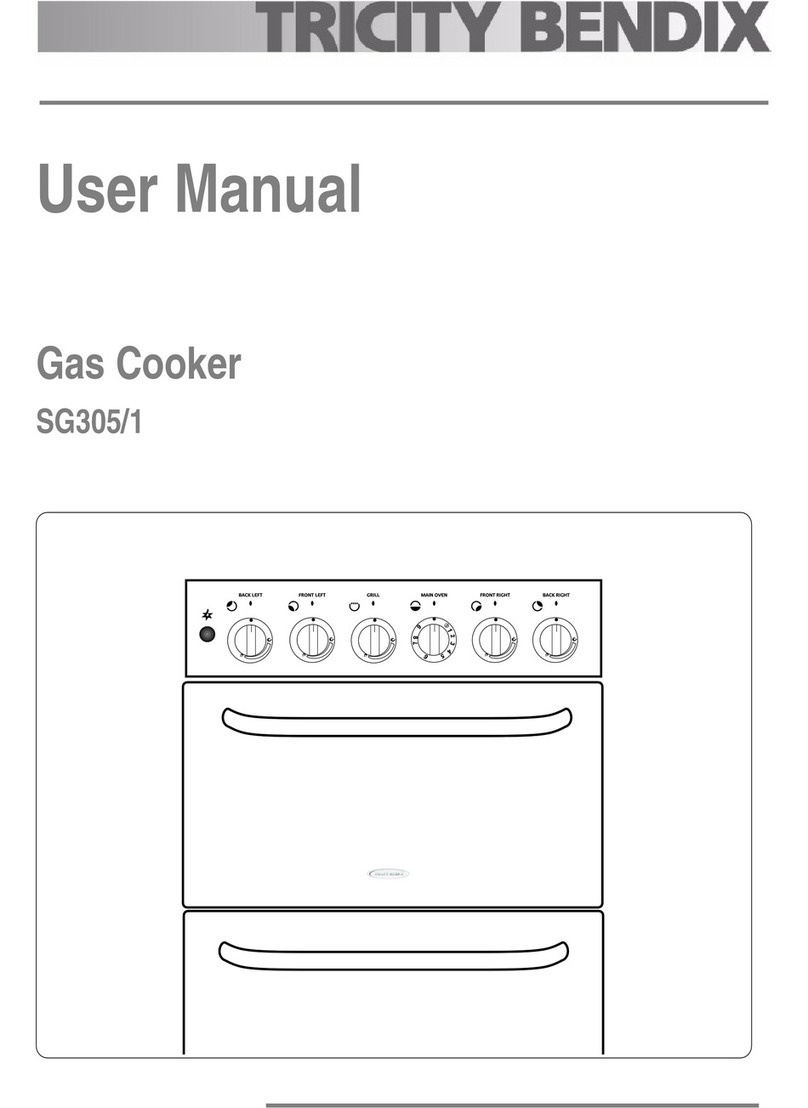
Tricity Bendix
Tricity Bendix SG305 user manual
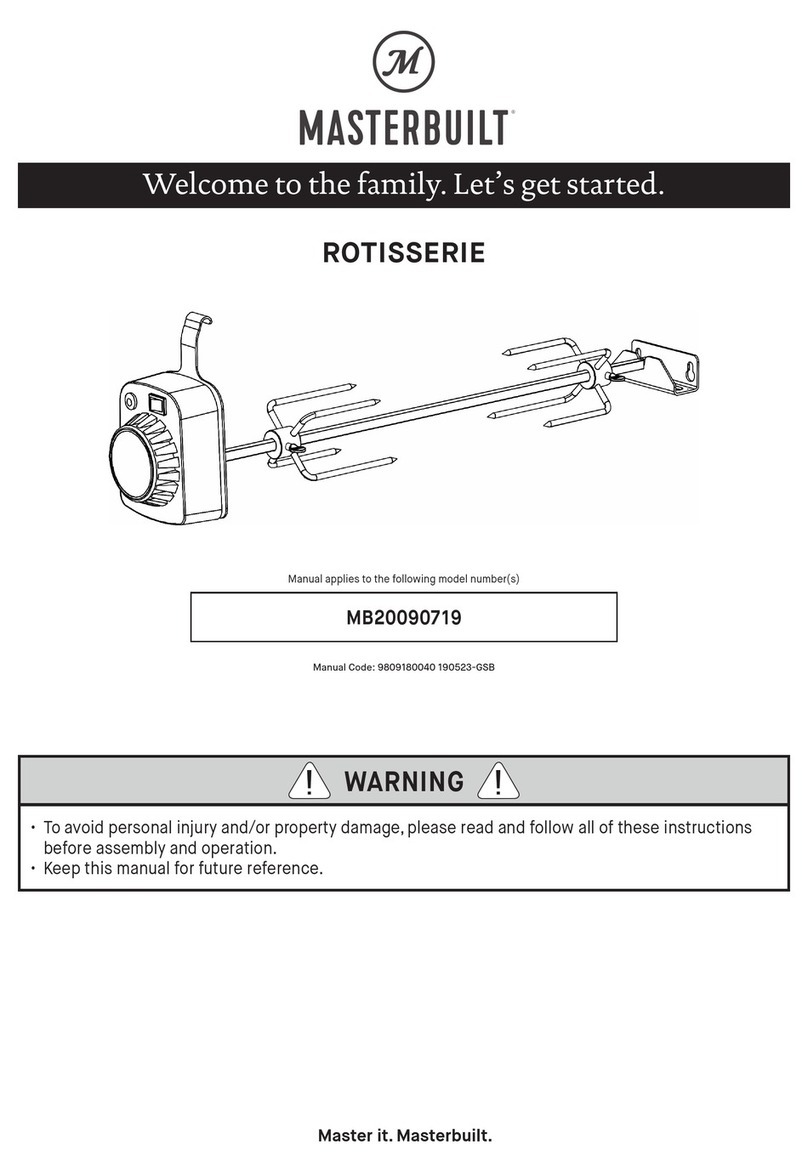
Masterbuilt
Masterbuilt MB20090719 Let's get started
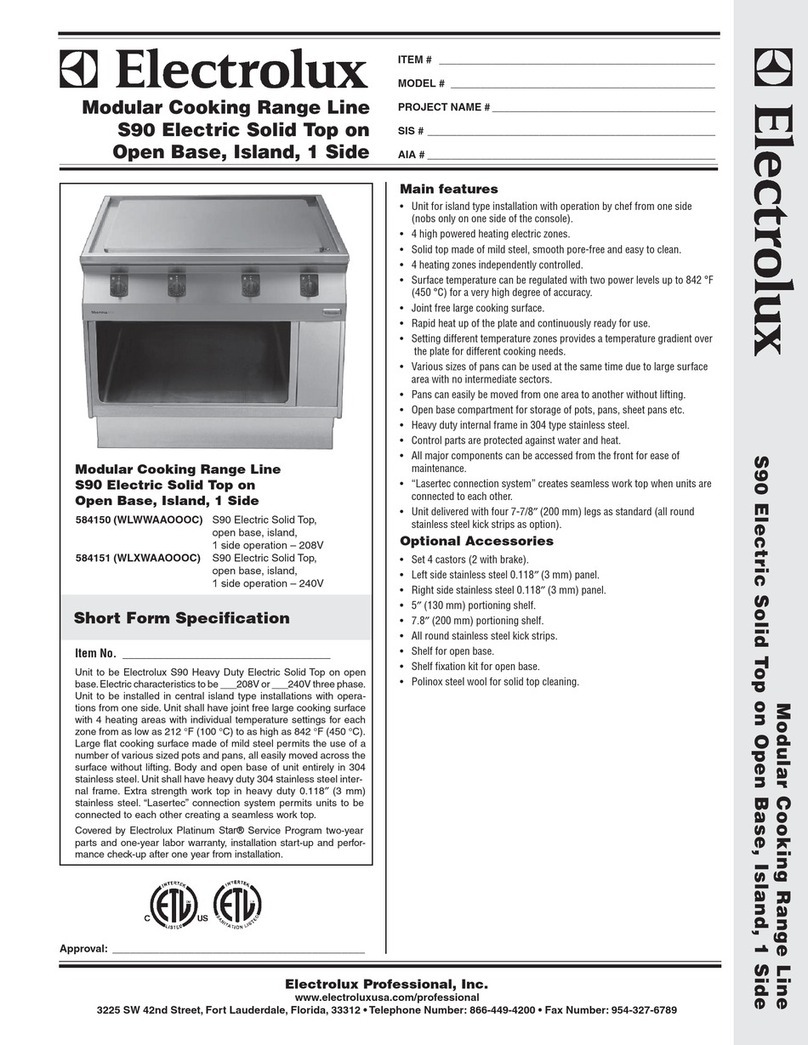
Electrolux
Electrolux 584150 Specification sheet
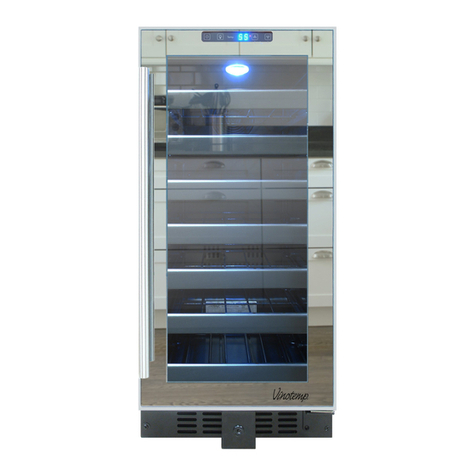
Vinotemp
Vinotemp VT-32TSFE-SM owner's manual

Silvercrest
Silvercrest SGR 150 A1 operating instructions
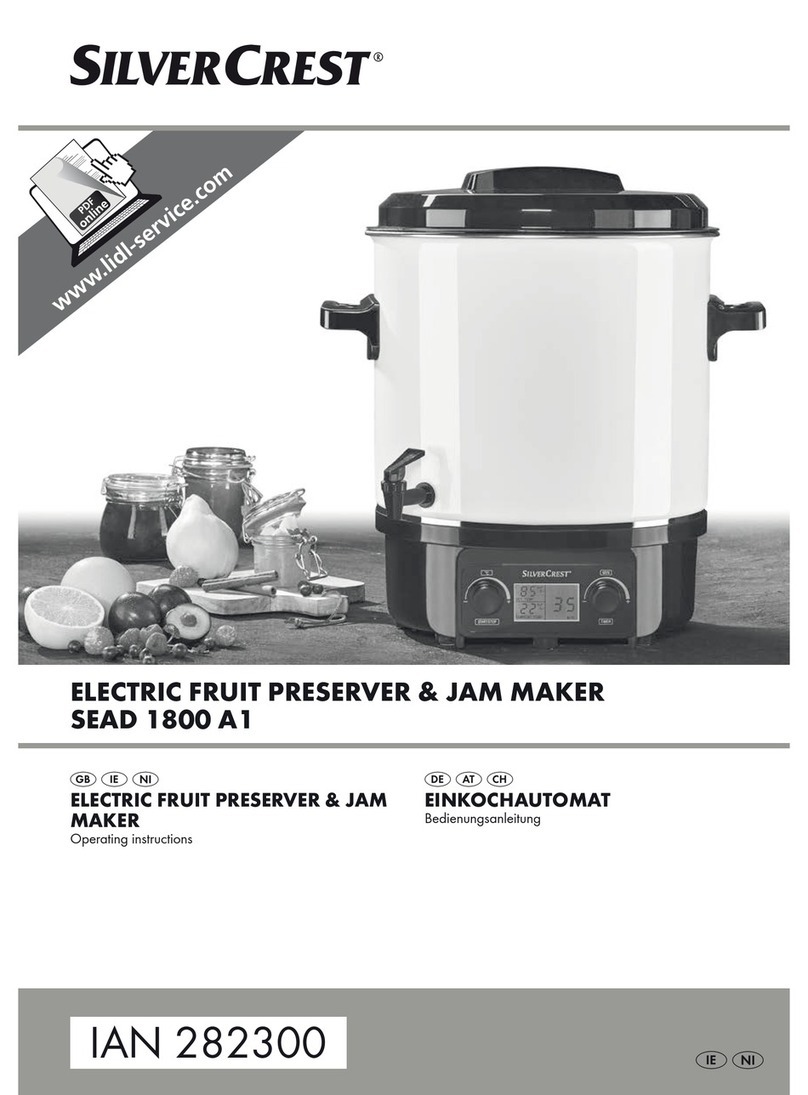
Silvercrest
Silvercrest SEAD 1800 A1 operating instructions
